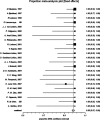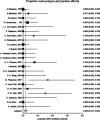Efficacy and safety of botulinum toxin type A for treatment of Frey's syndrome: evidence from 22 published articles
- PMID: 26310612
- PMCID: PMC4673990
- DOI: 10.1002/cam4.504
Efficacy and safety of botulinum toxin type A for treatment of Frey's syndrome: evidence from 22 published articles
Abstract
Frey's syndrome (FS) is an unavoidable sequela following the surgery of the parotid gland. Although several treatment methods are available, their efficacy is short term or accompanied by unacceptable complications. In the past two decades, botulinum toxin type A (BTXA) has been widely used to treat FS. Although several systematic reviews have been reported recently, they were conflicting and with obvious deficiencies. Thus, we performed an objectively systematic review to determine whether BTXA is an effective and safe treatment for FS. A literature retrieval covering PubMed, Web of Science, Ovid, Embase and Cochrane library was performed on 16 January, 2015. Proportion meta-analysis and corresponding 95% confidence interval (CI) were performed to evaluate the efficacy and safety of BXTA in treatment of FS. A total of 499 records were retrieved and 22 articles with 23 studies were included after scrutiny by two independent authors. Statistical analyses regarding the effective rate, incidence of complications were used to estimate the efficacy and safety of BTXA. Our results suggested that the effective rate of BTXA for treatment of FS is 98.5% (95% CI = 0.971-0.994) and the incidence of complication is 3.6% (95% CI = 0.017-0.061). In conclusion, our study supports that BTXA produces meaningful benefits on the treatment of patients with FS. However, owing to lack of strong evidence, future studies with well-designed inclusion criteria and multicenter randomized controlled trials are needed to give more credible evidence, if possible.
Keywords: Botulinum toxin type A; Frey's syndrome; efficacy; proportion meta-analysis; safety.
© 2015 The Authors. Cancer Medicine published by John Wiley & Sons Ltd.
Figures
References
-
- May JS. McGuirt WF. Frey’s syndrome: treatment with topical glycopyrrolate. Head Neck. 1989;11:85–89. - PubMed
-
- Linder TE, Huber A. Schmid S. Frey’s syndrome after parotidectomy: a retrospective and prospective analysis. Laryngoscope. 1997;107:1496–1501. - PubMed
-
- Laage-Hellman JE. Treatment of gustatory sweating and flushing. Acta Otolaryngol. 1958;49:132–143. - PubMed
-
- Laskawi R, Schott T, Mirzaie-Petri M. Schroeder M. Surgical management of pleomorphic adenomas of the parotid gland: a follow-up study of three methods. J. Oral Maxillofac. Surg. 1996;54:1176–1179. - PubMed
-
- Bjerkhoel A. Trobbe O. Frey’s syndrome: treatment with botulinum toxin. J. Laryngol. Otol. 1997;111:839–844. - PubMed
Publication types
MeSH terms
Substances
LinkOut - more resources
Full Text Sources
Other Literature Sources
Medical
Miscellaneous




